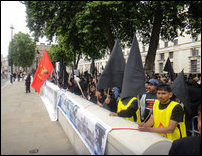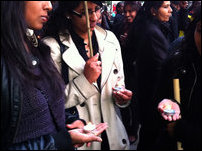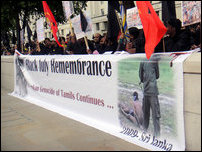Ilankai Tamil Sangam30th Year on the Web Association of Tamils of Sri Lanka in the USA |
|||
 Home Home Archives Archives |
Remembering Sri Lanka’s Long History of Mass Killing of Tamilsby TamilNet, 25 July 2011
British Tamils held a candle light vigil Saturday evening opposite the Prime Minister’s official residence, 10 Downing Street, to remember victims of Sri Lanka’s 1983 ‘Black July’ anti-Tamil pogrom. Six days of mob violence, organized by ruling politicians and abetted by Sri Lanka’s security forces, which began on July 23 that year killed over three thousand people, and emptied the capital, Colombo, of Tamils. On Saturday, a thousand British Tamils dressed in black and carrying black flags and Eelam national flags, held a vigil between 6 and 9 pm, with lit candles and banners commemorating the pogrom. For several hours before the vigil began, activists and supporters handed out leaflets in the surrounding Whitehall area. The events were organized by the British Tamil Forum. The banners highlighted the Sri Lankan state-backed mass killings of Tamils in the 1983 pogrom, and the armed forces slaughter of 40,000 Tamil civilians in the final months of the island’s war in 2009. Each was depicted by an image that have become iconic of the event. Amid the summer sunshine, thousands of tourists from around the world passed through the area in the afternoon and evening, along with many Londoners. Tamil activists, including survivors of the pogrom and those who lost relatives and friends in the bloodletting, as well as second generation youth, handed out leaflets and engaged the passers in responding to questions about the event and the history. “28 years ago, thousands of our people were massacred by thugs led by government politicians and supported by the security forces. The entire Tamil community was driven out of Colombo. But no one has been punished or even charged,” said BTF media coordinator Shan Sutha. “The world is increasingly becoming aware of the mass killings of 40,000 more Tamils in 2009. We are here to remind that there Sri Lanka has a longer history of mass killings of Tamils than five months [in 2009],” he told TamilNet, as tourists stopped to examine the posters behind him. The vigil was addressed by Jan Jananayagam of Tamils Against Genocide (TAG) and Ravi Kumar of the British Tamils Forum, speaking through loud hailers. “The present is thus inextricably linked to the past. And the past will also define the future,” Ms. Jananayagam said. “Until there is accountability for the mass atrocities against the Tamil people, until justice – the bedrock for any lasting peace - emerges, until Tamils are recognized as a people with equal rights and a rightful place in their homeland, the island’s northeast, Sri Lanka will remain synonymous with ethnic strife." The state’s objective in organizing the pogrom was to crush Tamil aspirations for self rule and economically weaken the community, she said, referring to the systematic looting and torching of Tamil-owned businesses. However, in this regard the pogrom had had inadvertent consequences, she said. "While Black July destroyed the Tamil economic base in the island, it created the now flourishing global Diasporic economic base. While it sought to silence Tamil political struggle ‘for once and for all’, it instead spread Tamil activism across the world. It sought to erase the Eelam Tamil cultural symbolism and identity, but instead rendered them globally recognized,” she said. A 38 year old Tamil, who joined the event with his young family, recalled his terrifying escape from the mobs. “I was ten [then]. We were chased down the street by people carrying swords and iron bars. We escaped, but I never saw some of classmates again.” He spoke to TamilNet on condition of anonymity as his parents were again living in Colombo. This year’s Black July remembrance also coincided with the 57th Commonwealth parliamentary conference in London for which around 700 parliamentarians and parliamentary officials from 54 countries are currently in London. Activists fixed a banner stating “146,679 killed or missing in Sri Lankan war on Tamils’ to the railings surrounding the Commonwealth flags erected on Parliament Square. Details of the Black July pogrom were carried in British press reports in 1983. The Daily Telegraph reported on July 26: “Motorists were dragged from their cars to be stoned and beaten with sticks. Others were cut down with knives and axes. Mobs of Sinhala youth rampaged through the streets, ransacking homes, shops and offices, looting them and setting them ablaze, as they sought out members of the Tamil ethnic minority.” The Economist said in an August 1983 article titled the ‘Wages of Envy’: “Two weeks ago Tamils owned 80% of the retail trade and 60% of the wholesale trade in the capital Colombo. Today that trade is gone. Food shortages and inflated prices are one result. The Tamil industrial base, built up over generations, is no more.” As the Economist also noted, “Restoring Sinhalese rights is a code phrase for dislodging the Tamils from their disproportionate influence over large sectors of the Sri Lankan economy. This is what the Sinhalese mobs set out to do when they put their torches to thousands of carefully targeted Tamil factories and shops.” |
||
|
|||










